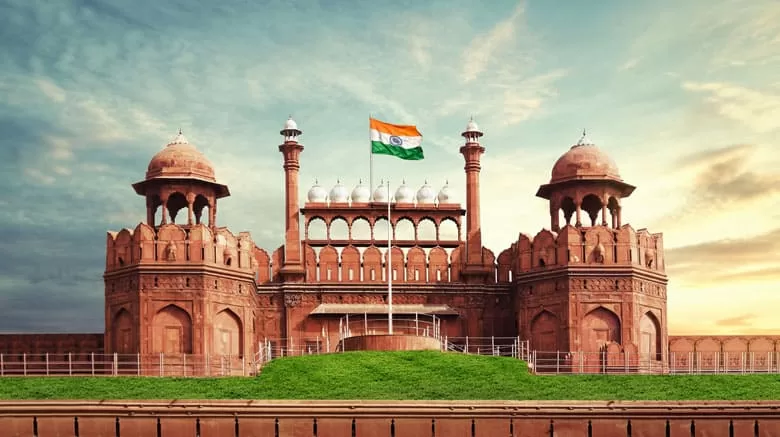Introduction
Lal Qila, or Red Fort, is the most distinguished of all historical monuments that India has. Built by Shah Jahan, the Mughal emperor, in the 17th century, this fort stands as a commanding testimony to India’s ancient history. The Red Fort is located in Delhi and is one of the sites where millions come to visit every year. Only beauty, history, and culture seem to be in favor of any site to become a legitimate point of interest.
What Is Lal Qila Like?
Lal Qila is a sprawling fort built primarily of red sandstone. It remained the primary residence of the Mughal emperors almost for 200 years. The fort is spectacular in its design, with vast, spacious courtyards, exquisite carvings, and splendid gardens. Listed as a UNESCO World Heritage Site since 2007, it holds tremendous historical and architectural significance.
Why Was Lal Qila Built?
Shah Jahan built the Red Fort in 1638 when he decided to shift the Mughal capital from Agra to Delhi. He wanted to build a great palace to represent the glory and power of the Mughal Empire. The fort was to act as a fortress but also as a sumptuous palace for the emperor and the courtiers. It has, year after year, seen important developments in Indian history, such as colonization by the British and the struggle for independence.
Architecture of Lal Qila
Red Fort is an exquisite manifestation of Mughal architecture. The architecture here is a fusion of Persian, Timurid, and Indian styles.
- Massive Walls: Huge red sandstone walls embellish the fort, which rises to 33 m and covers more than 2 km of the perimeter.
- Lahori Gate: Lahori Gate is the main entrance, and it is a majestic structure where guests are welcomed inside the fort complex.
- Diwan-i-Aam: The Diwan-i-Aam was the public audience hall where the Emperor delivered speeches to the masses and heard their complaints.
- Diwan-i-Khas: This private hall was used for conferences with nobles and senior officials and was home to the famous Peacock Throne.
- Moti Masjid: It is a small yet beautiful mosque made by Aurangzeb for personal prayers.
- Rang Mahal: Royal palace with exquisite mirror work and delicate artistry.
Historical Significance
Many events of great historical significance for India have found a place in the timeline of Lal Qila. Some prominent ones include:
- Mughal Dynasty: The fort became the epicenter of the Mughals from Shah Jahan’s time until the British took over in 1857.
- British Colonization: The British used the fort as a military establishment in the aftermath of the Revolt of 1857.
- Independence of India: The first Prime Minister of India, Jawaharlal Nehru, on August 15, 1947, unfurled the national flag inside the fort. Since then, this practice has continued to celebrate India’s Independence Day in Lal Qila.
Best Time to Visit
The best time to visit Lal Qila is in the months of winter, from October to March. The weather remains pleasant, so the excursion to the fort and its vicinity is comfortable. The fort is open for visiting all days of the week except Mondays.
Entry Fees and Timings
- Indian Citizens: INR 35 per person
- Foreign Tourists: INR 500 per person
- Timings: 9:30 AM to 4:30 PM (Closed on Mondays)
Light and Sound Show
The Light and Sound show telling the history of the fort with light and sound reverberating through the ambiance is one of the chief attractions of a visit to the Red Fort. It is conducted in Hindi and English for tourists from all over the globe.
How To Reach Lal Qila
Lal Qila is well connected to other areas in Delhi. Here are some routes to explore from where one can either walk or take a transport to the fort:
- By Metro: The nearest metro station is Chandni Chowk on the Yellow Line.
- By Bus: Several DTC buses run through this route.
- By Taxi/Rickshaw: Autorickshaws and taxis are available all over the place.
Nearby Attractions
If you are visiting Lal Qila, you can also explore:
- Jama Masjid: One of the largest mosques in India, just a few minutes away.
- Chandni Chowk: A bustling market is known for its street food, jewelry, and traditional goods.
- Raj Ghat: A memorial for Mahatma Gandhi.
- India Gate: A war memorial, a short drive.
Conclusion
Lal Qila is not merely a historical fort but an icon of India’s glorious past. Architecture, culture, and history roll into one; anyone visiting Delhi should make it a point to see this place. So, if you are the history buff kind or even an aspiring tourist marveling at the beauty, you will encounter experiences that can never be forgotten at the Red Fort.Do save your date for the little, great monument!


